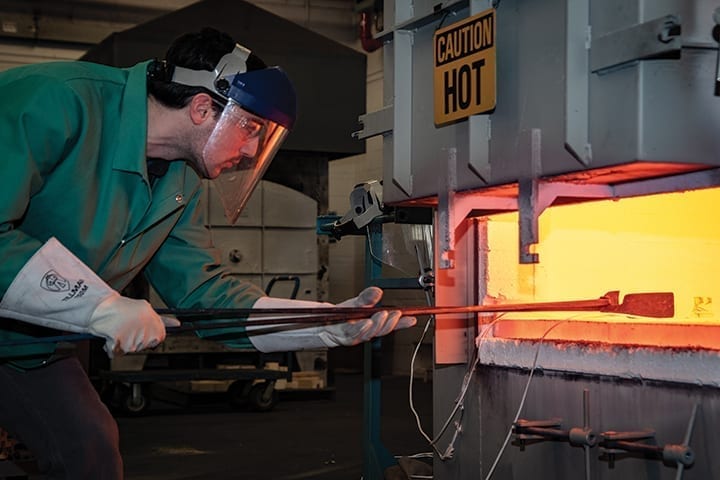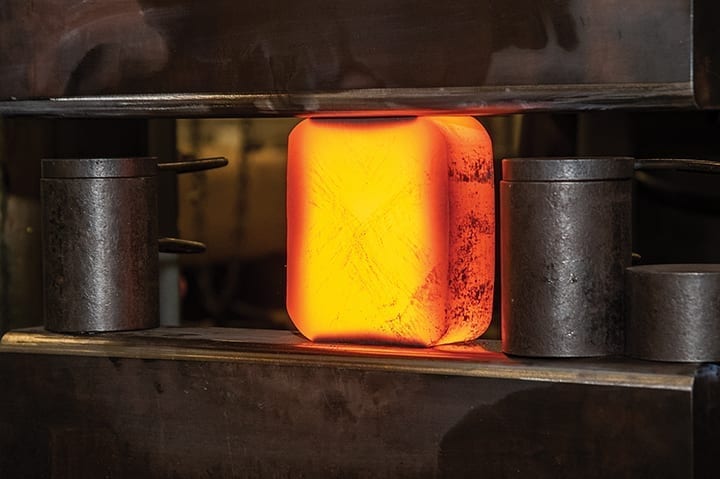Forging Materials with the ‘Right Stuff’ for Tomorrow’s Energy Systems
The post Forging Materials with the Right Stuff' for Tomorrow's Energy Systems appeared first on POWER Magazine.

One of the National Energy Technology Laboratory's (NETL's) key initiatives aims to bridge the gap in research infrastructure and accelerate advanced alloy development and manufacturing.
Materials are foundational technology, and they will continue to be an important focus of nearly all technology development. The development and deployment of highly flexible and efficient energy systems, such as advanced turbine systems, advanced gasification systems, advanced ultrasupercritical (AUSC) steam cycles, supercritical carbon dioxide (sCO 2) power cycles, and direct power extraction systems, are no exception.
The need to increase operating temperatures and pressures in order to increase efficiency, along with the need for flexible operations, are placing more demands on the materials used in these systems. Thus, there is tremendous need for improved cost-effective materials that can withstand the aggressive service environments involving high temperatures, high pressures, corrosive and oxidizing environments, hydrogen attack, and thermal-cycling conditions to improve efficiency and extend the life of electricity-producing power plants.
Developing High-Performance MaterialsThe National Energy Technology Laboratory (NETL) is at the forefront in designing and manufacturing advanced alloys used in harsh environments. These efforts, undertaken by the U.S. Department of Energy's (DOE's) Office of Fossil Energy (FE) and NETL's High-Performance Materials program, are focused on the development of improved alloys for deployment in both the existing fleet of power systems and new power-generating technology.
The High-Performance Materials program characterizes, produces, and certifies cost-effective alloys and high-performance materials suitable for extreme environments that are found in fossil-based power-generation systems. NETL supports and catalyzes a robust domestic materials supply chain that prepares materials for AUSC and related applications.
Transformational power technologies such as AUSC and sCO2 systems have the potential to increase efficiencies and reduce emissions. However, these systems operate at higher temperatures and pressures leading to more corrosive and harsher environments when compared to traditional power plants. Additionally, the diversification of power generation sources (that is, penetration of renewable sources) is transforming the electrical grid, resulting in assets and components being subjected to cyclic operating conditions. The extreme changes in temperatures and pressures brought on by cyclic conditions increases performance demands on materials of construction.
The High-Performance Materials program works to accelerate the development of improved steels, superalloys, and other advanced alloys to address challenges of both the existing fleet and future power systems. Materials of interest include those that enable components and equipment to perform in the high-temperature, high-pressure corrosive environments of an advanced energy system with specific emphasis on durability, availability, and cost.
Research Drives InnovationNETL's Research and Innovation Center supports the goals and objective of the High-Performance Materials program by conducting research aimed at developing affordable and durable materials that enable diverse energy technologies. NETL utilizes a combination of computational and experimental methods for translating materials science concepts into practical technologies. Key to this strategy are targeted experiments that evaluate performance in realistic service conditions and demonstrate manufacturing at scales that readily translate to industrial practice.
NETL's structural materials abilities and expertise are anchored by its substantial alloy fabrication and performance testing facilities housed at NETL's 42-acre research campus in Albany, Oregon. Research at Albany focuses on developing cost-effective materials for extreme stress and corrosive/erosive environments with service life of 100,000 hours. NETL maintains a complete alloy development research facility, which includes an alloy fabrication laboratory for prototyping alloy manufacturing with capabilities for melting (vacuum induction melting, vacuum arc remelting, and electroslag remelting), casting, forging, rolling, and heat-treating materials ranging in size from a few grams to 100 kilograms (Figure 1).
 |
1. The National Energy Technology Laboratory's (NETL's) Albany complex has specialized facilities for materials fabrication and performance testing of advanced high-temperature, corrosion-resistant structural ceramic composites and metal alloys. Source: NETL |
NETL's capabilities also include the Severe Environment Corrosion and Erosion Research Facility and related laboratories for assessing materials performance in simulated fossil fuel environments at high temperatures and pressures. Complementary computational materials research is integrated into these activities to guide alloy development and manufacturing research, and to predict materials performance and shorten development timelines.
These capabilities, coupled with the expertise of NETL researchers, have been responsible for implementing numerous materials solutions for energy technologies. Notable discoveries include:
- Corrosion-resistant refractory brick used in nearly all slagging gasifiers worldwide. The NETL refractory doubled performance in the slagging gasifier environment. The technology is licensed to refractory manufacturer HarbisonWalker International.
- An award-winning computational method to optimize heat treatments of large-scale castings from complex heat-resistant alloys, an enabling technology for manufacturing AUSC steam turbines. NETL provided homogenization heat treatments for demonstration casting in support of the AUSC program, including the homogenization heat treatment for the partial steam turbine valve casing demonstration casting from alloy Haynes 282.
- Sensor technology to monitor ingot production during vacuum arc remelting. This enhanced monitoring allows for better melt control and ingot quality, and contributes to reducing costs. The technology has been licensed to Ampere Scientific, a startup company, for commercialization.
Current NETL research continues to focus on developing improved alloys and techniques for manufacturing large-scale ingots for advanced energy systems. These efforts have enabled NETL to make several advancements, including:
- An Fe-9Cr ferritic/martensitic steel for extreme environments (close to 650C service).
- Several Ni-superalloys concepts that improve performance compared to alloys 282, 740H, and 725.
- High-entropy alloy development for energy applications.
Additional information about these efforts and others are posted on the Materials Engineering and Manufacturing section of the NETL website.
Extreme Environment MaterialsNETL alloy development also supports the DOE-FE eXtremeMAT consortium. Launched in 2018, eXtremeMAT consists of NETL and partner national laboratories Ames Laboratory, Idaho National Laboratory, Lawrence Livermore National Laboratory, Los Alamos National Laboratory, Oak Ridge National Laboratory, and Pacific Northwest National Laboratory. The consortium leverages the world-leading expertise and capabilities in the DOE complex associated with materials design, high-performance computing power, advanced manufacturing, in-situ characterization, and performance assessment in an integrated, collaborative, and coordinated effort to address the materials challenges associated with advanced energy systems.
In a short period of time, eXtremeMAT has made significant progress and developed a suite of models to predict creep rupture using a limited number of short-term creep tests and a first-generation engineering model to predict the performance of components subjected to multi-axial stresses and cyclic-loading conditions. The eXtremeMAT team has also identified several alumina-forming austenitic iron-based alloys with exceptional creep life compared to commercial alloys.
To build upon these successes and to continue to support the objectives of the High-Performance Materials program, NETL recently designated its Alloy Development and Manufacturing Competency as a key laboratory initiative. Through this initiative, NETL is planning to expand its state-of-the-art alloy design, ingot metallurgy, and thermomechanical processing capabilities in Albany (Figure 2). Design work has started while construction funding awaits congressional review and approval. The electricity and power generation sector in the U.S. is undergoing rapid transformation. This expansion of Albany's research capabilities will help produce the needed materials to ensure success as this paradigm shift is made.
 |
2. NETL-Albany is internationally recognized for its leadership in designing, developing, and deploying advanced materials for use in energy applications and extreme service environments. Source: NETL |
The expansion also will enable NETL to take fuller advantage of its melt processing and ingot metallurgy capabilities, which are among its unique capabilities within the DOE complex. Included in the plans are renovated laboratory space. This facility will house existing and new melt-processing capabilities, including capabilities to melt ultra-high-temperature alloys. As part of this initiative, NETL will focus on developing the next-generation alloys for energy application and feedstocks designed specifically to take full advantage of emerging advanced manufacturing methods.
One of the necessary components to drive success of the project is developing partnerships with other organizations to leverage capabilities and avoid costly duplication. This important consideration will be closely integrated into the Albany expansion.
A Proud History in Alloy DevelopmentNETL and its Albany site have been leaders in taking on challenging issues and projects, and finding solutions by working with other government agencies and private industry. Significant accomplishments have included:
- One of Albany's early landmark achievements was the development of a process for producing zirconium, which was chosen for use in the reactor of the first operational nuclear-powered submarine-the USS Nautilus. In this way, the lab helped usher in the modern U.S. Navy. This also led to the formation of spinoff companies that continue to be at the forefront of industry.
- Researchers at NETL and Boston Scientific developed a revolutionary coronary stent made from a unique platinum-chromium alloy. The alloy solved many of the problems found in traditional stents. Stents made from this material are both thin and visible on X-ray, and their flexibility allows easier movement through arterial bends without causing damage. The stents also have higher corrosion resistance, optimizing long-term stability within the body.
- Working with the Army Research Laboratory, NETL researchers developed a titanium alloy for personal body armor and prototype cast-steel vehicle armor that made U.S. troops safer during the Iraq war. NETL transferred its technology for making steel castings to the U.S. Army Rock Island Arsenal. A variant of this armor is used today to protect vehicles from improvised explosive device (IED) blasts.
Many of Albany's projects are and will be crosscutting activities because they foster technology development across applications in other industries. The expanded research facilities envisioned at Albany will not only address the critical need to develop alloys for advanced fossil energy systems, they will also be instrumental in developing high-performance materials for nuclear and renewable power generation, and chemical processing, as well as the aerospace, defense, transportation, and medical sectors, all of which are vital to our nation. Going forward, the scientists, engineers, and staff at NETL's Albany campus stand ready to expand their capabilities and add new chapters of success to the proud history of the site's service to the U.S.
-David Almanis associate director,Materials Engineering and Manufacturing,at the U.S. Department of Energy's
National Energy Technology Laboratory.
The post Forging Materials with the Right Stuff' for Tomorrow's Energy Systems appeared first on POWER Magazine.